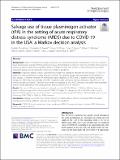Salvage use of tissue plasminogen activator (tPA) in the setting of acute respiratory distress syndrome (ARDS) due to COVID-19 in the USA: a Markov decision analysis
Author(s)
Choudhury, Rashikh; Barrett, Christopher D.; Moore, Hunter B.; Moore, Ernest E.; McIntyre, Robert C.; Moore, Peter K.; Talmor, Daniel S.; Nydam, Trevor L.; Yaffe, Michael B.; ... Show more Show less
Downloaddocument(2).pdf (600.0Kb)
Publisher with Creative Commons License
Publisher with Creative Commons License
Creative Commons Attribution
Terms of use
Metadata
Show full item recordAbstract
BACKGROUND: COVID-19 threatens to quickly overwhelm our existing critical care infrastructure in the USA. Systemic tissue plasminogen activator (tPA) has been previously demonstrated to improve PaO2/FiO2 (mmHg) when given to critically ill patients with acute respiratory distress syndrome (ARDS). It is unclear to what extent tPA may impact population-based survival during the current US COVID-19 pandemic. METHODS: A decision analytic Markov state transition model was created to simulate the life critically ill COVID-19 patients as they transitioned to either recovery or death. Two patient groups were simulated (50,000 patients in each group); (1) Patients received tPA immediately upon diagnosis of ARDS and (2) patients received standard therapy for ARDS. Base case critically ill COVID-19 patients were defined as having a refractory PaO2/FiO2 of < 60 mmHg (salvage use criteria). Transition from severe to moderate to mild ARDS, recovery, and death were estimated. Markov model parameters were extracted from existing ARDS/COVID-19 literature.RESULTS: The use of tPA was associated with reduced mortality (47.6% [tTPA] vs. 71.0% [no tPA]) for base case patients. When extrapolated to the projected COVID-19 eligible for salvage use tPA in the USA, peak mortality (deaths/100,000 patients) was reduced for both optimal social distancing (70.5 [tPA] vs. 75.0 [no tPA]) and no social distancing (158.7 [tPA] vs. 168.8 [no tPA]) scenarios. CONCLUSIONS: Salvage use of tPA may improve recovery of ARDS patients, thereby reducing COVID-19-related mortality and ensuring sufficient resources to manage this pandemic. ©2020
Date issued
2020-04-20Department
Koch Institute for Integrative Cancer Research at MITJournal
World Journal of Emergency Surgery
Publisher
Springer Science and Business Media LLC
Citation
Choudhury, Rashikh, et al., "Salvage use of tissue plasminogen activator (tPA) in the setting of acute respiratory distress syndrome (ARDS) due to COVID-19 in the USA: a Markov decision analysis." World Journal of Emergency Surgery 15, 1 (Apr. 2020): no. 29 doi 10.1186/s13017-020-00305-4 ©2020 Author(s)
Version: Final published version
ISSN
1749-7922
Keywords
Surgery, Emergency Medicine